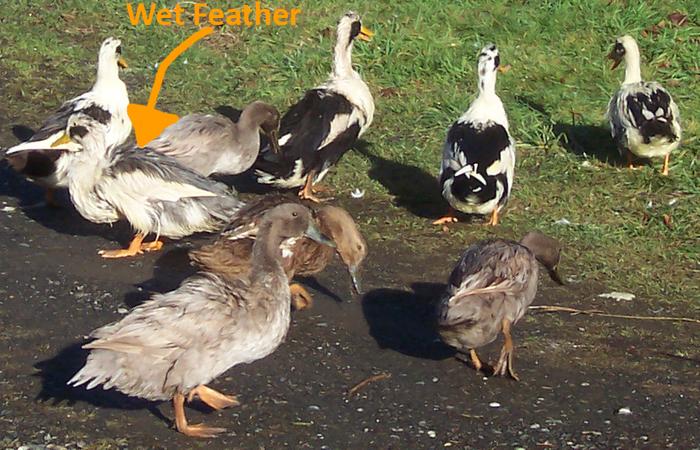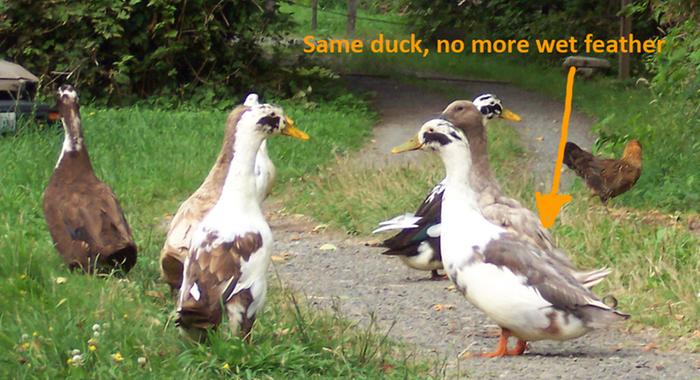
 2
2




'Theoretically this level of creeping Orwellian dynamics should ramp up our awareness, but what happens instead is that each alert becomes less and less effective because we're incredibly stupid.' - Jerry Holkins
 1
1








'Theoretically this level of creeping Orwellian dynamics should ramp up our awareness, but what happens instead is that each alert becomes less and less effective because we're incredibly stupid.' - Jerry Holkins




Dillon Nichols wrote:
Your pond has not cleared up in a month; how long were the ducks in there for? And what type are yours? What depth is the pond? Any sort of metrics like this are a great starting point!
Another duck was even worse, having an open sore on her breast. We'd almost got her healed back up when she somehow managed to get in our water pail and died of hypothermia. We thankfully managed to bring Remington back from the brink with warm water baths, lots of clean water and bedding, and lots of food available right next to him so that he could recover.


So far my young ponds have a really impressive array of bugs and amphibs very soon after construction, but no truly aquatic plant life.




Nicole Alderman wrote:
Dillon Nichols wrote:
Your pond has not cleared up in a month; how long were the ducks in there for? And what type are yours? What depth is the pond? Any sort of metrics like this are a great starting point!
We have mallard-type ducks (a banyard mix of ancona, magpie, runner, white layer, blue sweedish and cayuga). The ducks had been there, off and on, since October or November of the year before. As long as new water was flowing in, the water stayed relatively clean. Once the seasonal creek dried up, the pond stopped filling enough to drain out. That happened sometime in...late May? Early June? The pond was filthy by the time I fell into it. That was July 31st. The pond was still at least 5 feet deep (I was up to my neck in it) and the deeper parts are a good two+ feet deeper than that.
I found some pictures of my ponds in this thread.
Pond when it's full:

Pond when it's about as deep as it was when I fell in:


The pictures only show about 2/3rds of the pond. There's a bit more to the left behind the bushes there. It's a pretty big pond! If the mucky picture is 5 feet deep, the whole pond is 15+ feet deep at it's fullest. And, I only has 8-13 ducks in it. My ducks haven't been in it since July 31st (when I fell in), and it still looks mucky, a month and a half later. I always provide them fresh water in their trays, even when they have access to the pond, to prevent wet feather.
This is what wetfeather looks like, all the ducks have it various degrees of severity. The one with the arrow pointing to, is Remington. We still have him, and he's all better now. But, here's what I wrote two years ago about it:
Another duck was even worse, having an open sore on her breast. We'd almost got her healed back up when she somehow managed to get in our water pail and died of hypothermia. We thankfully managed to bring Remington back from the brink with warm water baths, lots of clean water and bedding, and lots of food available right next to him so that he could recover.


I feel horrible that I did not notice what was wrong with my ducks sooner at the time. Keeping animals has a learning curve, even when you read everything you can about them before getting them (which I did!). I don't want anyone else to learn the hard way (with their animals suffering) like I did.
So far my young ponds have a really impressive array of bugs and amphibs very soon after construction, but no truly aquatic plant life.
That life will greatly diminish once the ducks get in there! We used to have swarms of gorgeous, giant green dragonflies and smaller red ones. Now, we only see a few. The ducks eat the larve the the dragonflies lay in the water. I'm still really sad about our lack of dragonflies now. There also used to be more little frogs, and a lot more bullfrogs. Now there's much less of both of those. There's a lot less mosquitoes, too, though...
'Theoretically this level of creeping Orwellian dynamics should ramp up our awareness, but what happens instead is that each alert becomes less and less effective because we're incredibly stupid.' - Jerry Holkins

| I agree. Here's the link: http://stoves2.com |






